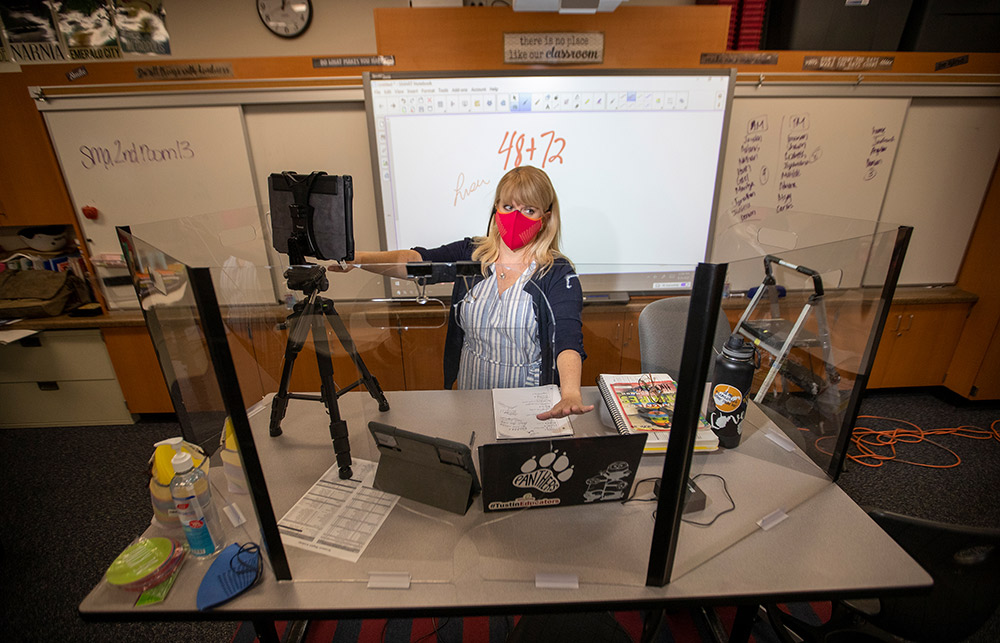这四个方面的改变,将使线上课堂大不一样

以前,新学年的准备工作就像返校购物一样简单。买文件夹、笔记本、铅笔和钢笔。或许还会买个新书包。
但就像大卖场的处境一样,2021年,随着新冠疫情迫使教育行业转至线上,我们必须重新思考学生需要为2021学年做好哪些准备。数字课堂本身依赖电子设备和远程网络连接,这让许多学生、老师和家庭陷入困境。
公平地为所有学生提供现代课堂所需要的装备,需要集体的努力。(三星电子美国公司是一家技术提供商,也是许多美国教育机构的合作伙伴。)以下四项投资可以确保所有师生都不会错过学习机会:
解决网络连接差距
疫情暴露出一个问题,许多美国人连基本的上网条件都不具备。研究显示,有数以百万计的美国学生在疫情居家学习期间无法使用互联网。如果没有网络连接,电子设备和其他技术也就毫无用处,因此解决缺网问题是保证每个学生都能参与电子课堂的关键第一步。
公共和私营部门都可以为解决这个问题发挥各自的作用。例如,公共部门可以扩大联邦教育补助项目的资格范围。一直以来,这些项目都支持学校和图书馆使用价格便宜的宽带,但如果也允许个人家庭参与其中,数以百万计的学生就将有机会使用网络。
而私营部门的首要任务是想方设法把5G网络连通到更多家庭,同时研究如何调整现有技术以增加网络连接。例如,发展中国家通常使用基于移动流量和手机SIM卡的设备提供5G网络,如笔记本电脑使用USB加密狗就可以连接到移动互联网。这些方法在美国并不常见,但可以用来在网络覆盖情况较差的地区为学生提供网络连接。
扩展教师的职业技能
在疫情爆发时,大部分老师和学生几乎在一夜之间不得不转为虚拟学习模式。他们没有时间练习有效的在线教学策略。
但在2021 - 2022学年开始之前,教育工作者、学校负责人和技术人员有机会根据学生和老师使用的数字工具,共同研究、创建、测试和整合有效的教学策略。这将帮助师生充分利用课堂上的时间,创造有效的、个性化的学习体验。
合作改善虚拟学习体验
为了打造可持续的远程学习体验,关键在于持续合作。例如,在加利福尼亚州,谷歌(Google)与当地政府官员合作,向本地学生捐赠了4,000台急需的Chromebook笔记本,并向10万个偏远地区的家庭提供免费Wi-Fi。在缅因州,三星(Samsung)与该州教育部门合作,为有确切需求的学生提供网络连接和设备。
教育生态系统内部也需要加强合作。在缅因州,各层面的合作与沟通是其成功部署虚拟学习的关键。除了定期与校区主管和技术负责人联系以外,缅因州教育部门还针对学生反馈的虚拟学习体验,为从四年级到大学一年级的学生创建了一个咨询委员会。该部门还与家长、老师、顾问和学校负责人进行了分组讨论。
建立技术储备
研究显示,440万有孩子的美国家庭都不能保证子女始终有计算机可以用于在线学习。更糟糕的是,2020年,学校纷纷转为远程学习后对计算机的需求激增,美国各地学校都出现过设备短缺的问题。随着供应恢复到疫情之前的水平,现在学校应该从长远出发,考虑储备一批设备。
一劳永逸的解决方案
从全世界因为疫情发生彻底改变至今已经过去一年之久。
我们在思考未来发展方向时,必须结合2020年的经验教训,为学生打造更好的学习体验,最终为学生们创造更美好的未来。我们今天为他们提供的工具和技巧,将影响他们成年之后如何回报社会。
远程学习并不是针对临时问题的临时解决方案。它是一次宝贵的机会,让我们可以重新定义学校、学生的学习能力以及未来劳动力的技术熟练程度。(财富中文网)
本文作者塔赫尔·贝博哈尼现任三星电子美国移动B2B业务部门负责人。
翻译:刘进龙
审校:汪皓
以前,新学年的准备工作就像返校购物一样简单。买文件夹、笔记本、铅笔和钢笔。或许还会买个新书包。
但就像大卖场的处境一样,2021年,随着新冠疫情迫使教育行业转至线上,我们必须重新思考学生需要为2021学年做好哪些准备。数字课堂本身依赖电子设备和远程网络连接,这让许多学生、老师和家庭陷入困境。
公平地为所有学生提供现代课堂所需要的装备,需要集体的努力。(三星电子美国公司是一家技术提供商,也是许多美国教育机构的合作伙伴。)以下四项投资可以确保所有师生都不会错过学习机会:
解决网络连接差距
疫情暴露出一个问题,许多美国人连基本的上网条件都不具备。研究显示,有数以百万计的美国学生在疫情居家学习期间无法使用互联网。如果没有网络连接,电子设备和其他技术也就毫无用处,因此解决缺网问题是保证每个学生都能参与电子课堂的关键第一步。
公共和私营部门都可以为解决这个问题发挥各自的作用。例如,公共部门可以扩大联邦教育补助项目的资格范围。一直以来,这些项目都支持学校和图书馆使用价格便宜的宽带,但如果也允许个人家庭参与其中,数以百万计的学生就将有机会使用网络。
而私营部门的首要任务是想方设法把5G网络连通到更多家庭,同时研究如何调整现有技术以增加网络连接。例如,发展中国家通常使用基于移动流量和手机SIM卡的设备提供5G网络,如笔记本电脑使用USB加密狗就可以连接到移动互联网。这些方法在美国并不常见,但可以用来在网络覆盖情况较差的地区为学生提供网络连接。
扩展教师的职业技能
在疫情爆发时,大部分老师和学生几乎在一夜之间不得不转为虚拟学习模式。他们没有时间练习有效的在线教学策略。
但在2021 - 2022学年开始之前,教育工作者、学校负责人和技术人员有机会根据学生和老师使用的数字工具,共同研究、创建、测试和整合有效的教学策略。这将帮助师生充分利用课堂上的时间,创造有效的、个性化的学习体验。
合作改善虚拟学习体验
为了打造可持续的远程学习体验,关键在于持续合作。例如,在加利福尼亚州,谷歌(Google)与当地政府官员合作,向本地学生捐赠了4,000台急需的Chromebook笔记本,并向10万个偏远地区的家庭提供免费Wi-Fi。在缅因州,三星(Samsung)与该州教育部门合作,为有确切需求的学生提供网络连接和设备。
教育生态系统内部也需要加强合作。在缅因州,各层面的合作与沟通是其成功部署虚拟学习的关键。除了定期与校区主管和技术负责人联系以外,缅因州教育部门还针对学生反馈的虚拟学习体验,为从四年级到大学一年级的学生创建了一个咨询委员会。该部门还与家长、老师、顾问和学校负责人进行了分组讨论。
建立技术储备
研究显示,440万有孩子的美国家庭都不能保证子女始终有计算机可以用于在线学习。更糟糕的是,2020年,学校纷纷转为远程学习后对计算机的需求激增,美国各地学校都出现过设备短缺的问题。随着供应恢复到疫情之前的水平,现在学校应该从长远出发,考虑储备一批设备。
一劳永逸的解决方案
从全世界因为疫情发生彻底改变至今已经过去一年之久。
我们在思考未来发展方向时,必须结合2020年的经验教训,为学生打造更好的学习体验,最终为学生们创造更美好的未来。我们今天为他们提供的工具和技巧,将影响他们成年之后如何回报社会。
远程学习并不是针对临时问题的临时解决方案。它是一次宝贵的机会,让我们可以重新定义学校、学生的学习能力以及未来劳动力的技术熟练程度。(财富中文网)
本文作者塔赫尔·贝博哈尼现任三星电子美国移动B2B业务部门负责人。
翻译:刘进龙
审校:汪皓
Preparing for a new academic year once was as simple as back-to-school shopping. Binders and notebooks. Pencils and pens. Maybe a new backpack.
But like the big-box stores themselves, the resources that students in 2021 require for a new school year have experienced a dramatic reimagination, as the coronavirus pandemic has pushed—rather harshly for many students, teachers, and families—the education sector into a digital model, one whose classrooms are inherently reliant on devices and remote connectivity.
Equitably outfitting students for the modern classroom is a collective effort. (Samsung Electronics America is a technology supplier and partner for educational institutions across the country.) Here are four investments to make now to ensure learning is accessible for all students and teachers:
Bridge the connectivity gap
The pandemic revealed that basic Internet access is not a reality for many in the U.S., with research showing that millions of students did not have Internet while home during the pandemic. Without connectivity, access to devices and other technologies is futile, so closing the gap is a critical first step to ensuring every student can participate in the digital classroom.
The public and private sectors both have roles to play in solving this problem. In the public sector, for example, e-rate program eligibility could be expanded. These programs have historically allowed schools and libraries to obtain affordable broadband, but could give millions of students the opportunity to connect if private households qualified as well.
Finding ways to bring 5G into more homes should be a top priority for the private sector, along with examining how existing technologies can be reimagined to increase connectivity. For example, in developing countries, devices that function on mobile data and mobile SIM cards are often used to provide 5G connectivity, as are laptops with USB keys that can connect to mobile Internet. These approaches are not common in the U.S., but could be introduced to give access to students in low-coverage areas.
Expand professional development for teachers
When the pandemic started, most teachers and students had to adapt to virtual learning practically overnight. The time to practice effective online teaching strategies was nonexistent.
But ahead of the 2021–2022 school year, there is an opportunity for educators, school leaders, and technologists to come together to research, build, test, and incorporate effective strategies that account for the digital tools students and teachers are using. This will help create an effective, personalized learning experience that makes the most of class time.
Partner to improve the virtual experience
To create a sustainable remote learning experience, ongoing collaboration will be critical. In California, for example, Google joined forces with state officials to donate 4,000 Chromebooks to the California students in greatest need and free Wi-Fi to 100,000 rural households. And in Maine, Samsung collaborated with the state education department to provide Internet access and devices to students with reported need.
Partnership is also necessary within the education ecosystem itself. In Maine, collaboration and communication at every level was key to their success in deploying virtual learning. In addition to regular contact with school districts’ superintendents and technology directors, the state’s education department created an advisory cabinet of students—from fourth graders to college freshmen—for feedback on the virtual learning experience. The department also conducted focus groups with parents, teachers, counselors, and school leaders.
Build a technology reserve
Research shows that 4.4 million U.S. households with children do not have consistent access to computers for online learning. In 2020, that challenge was compounded as demand surged during the transition to remote learning and schools across the country faced a device shortage. With supply starting to return to pre-COVID levels, now is the time for schools to consider proactively building a reserve of devices.
A permanent solution
It has been one year since our world forever changed as a result of the pandemic.
As we consider the path forward, we must use the lessons learned in 2020 to create a better learning experience—and ultimately, a better future—for our students. The tools and techniques we equip them with today will shape how they can contribute to society as adults.
Remote learning is not a temporary solution to a temporary problem. It's an opportunity to broaden our definition of school, students’ capacity for learning, and the technological proficiency of tomorrow’s workforce.
Taher Behbehani is head of the mobile business-to-business division at Samsung Electronics America.













